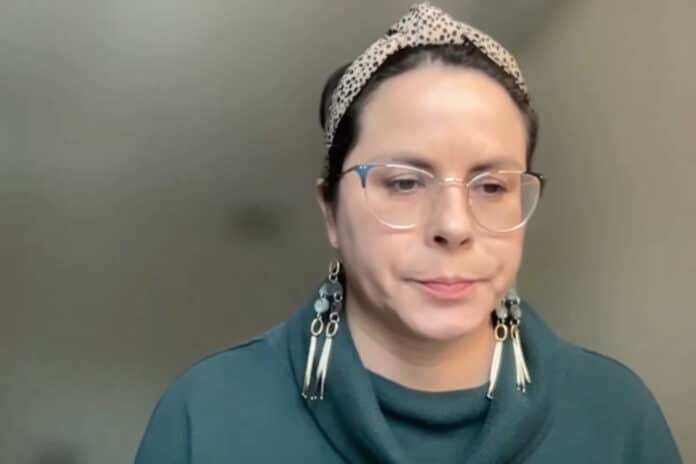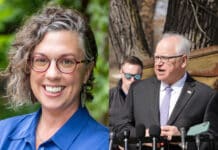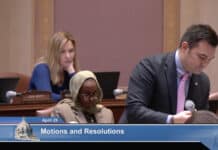
The State Emblems Redesign Commission charged with creating a new flag and seal for Minnesota made one more modification to its final state seal rendering on Tuesday, a full week after it had indicated it had completed that task. It did end up finalizing a design for a new state flag. It plans to meet next week to construct a report for the legislature explaining its final designs and its work over the last four months. A state statute creating the commission requires it to submit that report by Jan. 1.
While the Dec. 19 meeting had been planned to be entirely focused on making final modifications to the state flag design the commission had chosen just four days prior, one member, Michael Harralson, proposed a modification to the design that would change the number of gold “boxes” that border the circular seal to 98, a nod to Minnesota’s 87 counties and 11 sovereign tribes. Harralson is a tribal law attorney and judge and was one of Gov. Tim Walz’s three appointments to the commission.
The commission ultimately voted to approve that change, but not before two of its members engaged in an emotionally charged dialogue over whether the final seal design may be in violation of the statute instructing it to avoid “(s)ymbols, emblems, or likenesses that represent only a single community or person.”
Rep. Bjorn Olson, R-Fairmont, who is one of four legislators who sit on the commission as non-voting members, said he felt the direction the commission has gone with its final design modifications over the last seven days will likely open it to potential legal challenges.
Last week the commission voted to remove the state motto “L’etoile du Nord” from the final seal design and replace it with a Dakota language phrase “Mni Sota Makoce” (pronounced “min-eh-so-tah me-coach-ay”), which translates to “Land where the waters reflect the sky.” The commission also voted to remove the statehood year “1858” from the seal after commissioner Kate Beane argued that it was a “hurtful” date for many indigenous people living in Minnesota and that statehood was “not worth celebrating.”
On Tuesday, Beane responded to Olson’s concerns that the addition of the phrase “Mni Sota Makoce” contains elements of cultural favoritism, in violation of the instructions given to the commission.
“Those (existing flag and seal) designs were about erasure,” Beane said. “As native people on this committee we were asked to help represent that Native people are still here.”
“Many in our communities do not support this colonial government and state,” Beane continued. “That’s a reality. But we pay taxes. We are citizens … when we advocate for our own people who have been historically marginalized, that doesn’t mean we are excluding others, that’s a western concept.”
Beane was selected to the committee as a representative of the Capitol Area Architectural and Planning Board, which is chaired by Lt. Gov. Peggy Flanagan. She is the executive director for the Minnesota Museum of American Art and was one of the founding organizers of a movement that began nearly a decade ago to rename Lake Calhoun in Minneapolis. She also teaches at the University of Minnesota.
The statute instructs that the commission’s designs “must accurately and respectfully reflect Minnesota’s shared history, resources, and diverse cultural communities.
“Symbols, emblems, or likenesses that represent only a single community or person, regardless of whether real or stylized, may not be included in a design. The commission may solicit and secure the voluntary service and aid of vexillologists and other persons who have either technical or artistic skill in flag construction and design, or the design of official seals, to assist in the work.”
Another member of the commission, Aaron Wittnebel, who last week objected to the addition of the “Mni Sota Makoce” phrase on the seal, said he also did not favor adding any references to the tribes on the state seal. Wittnebel, who was appointed to the commission by the Minnesota Indian Affairs Council to represent the Ojibwe Community, said on Tuesday that the “position of the Ojibwe communities is that they are not represented on the great seal … it’s a tool of government.”
“Our feeling is that this is a symbol of state authority and state government, and to mix them together confuses that sovereignty.”
Hank Long
Hank Long is a journalism and communications professional whose writing career includes coverage of the Minnesota legislature, city and county governments and the commercial real estate industry. Hank received his undergraduate degree at the University of Minnesota, where he studied journalism, and his law degree at the University of St. Thomas. The Minnesota native lives in the Twin Cities with his wife and four children. His dream is to be around when the Vikings win the Super Bowl.















